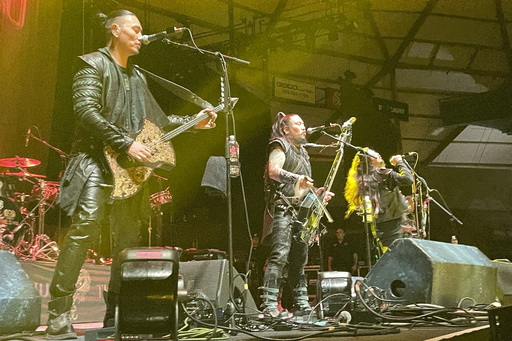
(RNS) — The Hu, an eight-member heavy metal ensemble from Mongolia, has achieved the remarkable feat of founding a new folk-metal genre, breaking through in a modern music landscape that many believed was saturated. Clad in 13th-century-inspired black war attire, the band performs songs that pay homage to Mongolian deities and historical figures like the legendary Genghis Khan.
Despite their groundbreaking achievements, including becoming the first Mongolian group to top a Billboard chart in 2019 and amassing 780 million streams on Spotify, their messages about themes such as warfare, destiny, and climate change often go unnoticed amid the striking visual and auditory performance they deliver. During a recent concert with heavy metal legends Iron Maiden at the Tacoma Dome in Washington state, the lead vocalists showcased their long black hair and unique style, belting out lyrics using traditional throat singing techniques.
At the core of their music lies a shamanistic spiritual essence that honors Tengri, a sky deity representative of Mongolian folk beliefs, shared by about 5% of the population. The nation’s spiritual landscape is diverse, consisting of around 50% Tibetan Buddhists, 40% atheists—largely influenced by 70 years of Soviet Communism—along with small numbers of evangelicals, Tengrists, shamans, Muslims, Mormons, and Catholics.
Shamanistic rituals often involve communicating with spirits or ancestors, and while The Hu doesn’t claim to be composed of shamans, their early track “Shoog, Shoog” serves as a call to spiritual ancestors. Lead singer Temuulen “Temka” Naranbaatar, who also plays the electric “tovshuur,” first delved into spiritual inquiries when he joined the band in 2016, expressing a curiosity about Christianity and participating in church gatherings but saying it was merely exploratory co-living.
His musical journey connected him with Bayarmagnai Dashdondog, an established figure in Mongolia’s pop music scene who served as a songwriter and producer for The Hu. The band members resonated deeply with the natural themes inherent in Dashdondog’s lyrics, linking them to their nomadic traditions. “The traditions of Tengerism are very intertwined with our culture, our lifestyle as nomads. That’s a part of why I am who I am,” Temka indicated.
Dashdondog, who originates from Mongolia’s western Khovd province, draws inspiration from his cultural roots as well as his family’s legacy, allowing these elements to enrich the band’s music. His compositions, honoring the “glory of our ancestors” and referencing sacred sites such as the Khaldun mountain, celebrated as Genghis Khan’s birthplace, are woven through songs like “This is the Mongol” and “Upright Destined Mongol.”
Temka further elaborated on their beliefs: “Tengerism implies that our ancestors are protecting us, but it doesn’t conform to a strict religious structure like the Bible or Quran. It’s about being guided by our ancestral spirits.” In mid-2018, Dashdondog arranged for The Hu to embark on a 3,100-mile journey across western Mongolia to record visuals for their poignant track “Yuve, Yuve, Yu.” The result was a remarkable music video that captivated the audience with its stunning cinematography and reverent representation of Mongolian culture.
Following this success, their video for “The Wolf Totem,” featuring a gallant horseman holding a black Mongolian war banner, showcased a crew of leather-clad men on motorcycles reciting battle chants, quickly racking up millions of views on YouTube. Though Dashdondog’s influence is substantial, the band’s individual spiritual identities are diverse. When The Hu was formed, two out of the four additional members had Christian upbringings, including guitarist Jambaldorj “Jamba” Ayush and drummer Odbayar “Odko” Gantumur, who was affiliated with a church.
Facebook reveals glimpses of Odko’s past with posts referencing Christian music and inspirational quotes, while Temka emphasized their collaborative energy, regardless of their varied backgrounds. “We maintain a high level of tolerance for differing beliefs,” Temka asserted. “Together, our energies align, bringing us closer as a band.”
In their day-to-day life, just before performances, the group unites for a brief gathering, calling upon shared energy and chanting the word “hu,” which plays a pivotal role in keeping them synchronized on stage. Temka mentioned, “In that moment, we invoke our ancestors collectively. With eight members, our aim is to merge our energies, which in turn energizes our audience and allows them to comprehend the essence of our songs, even without translations.”
